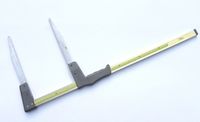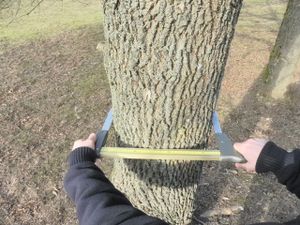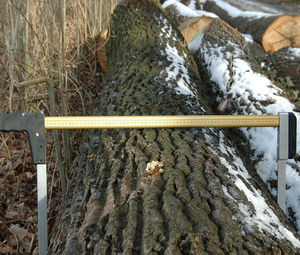Caliper
| (9 intermediate revisions by 2 users not shown) | |||
| Line 1: | Line 1: | ||
| − | {{ | + | {{Ficontent}} {{video|link=https://youtu.be/17NPkVXteiI}} |
| − | + | ||
| − | + | ||
| − | + | ||
==General description== | ==General description== | ||
The caliper is one of the most efficient tools to measure [[Tree diameter|stem diameters]] directly wherever one has direct access to the [[Tree Definition|stem]]. An ordinary caliper, constructed of metal or wood, consists of a graduated beam with two arms perpendicular to it. One arm is used at the origin of the scale and the other arm slides (Figure 1). When the beam is pressed against the tree and the arms are closed, the tree diameter can be read on the scale. | The caliper is one of the most efficient tools to measure [[Tree diameter|stem diameters]] directly wherever one has direct access to the [[Tree Definition|stem]]. An ordinary caliper, constructed of metal or wood, consists of a graduated beam with two arms perpendicular to it. One arm is used at the origin of the scale and the other arm slides (Figure 1). When the beam is pressed against the tree and the arms are closed, the tree diameter can be read on the scale. | ||
| Line 10: | Line 7: | ||
[[File:caliper.jpg|thumb|right|200px|Typical example of a caliper (60 cm).]] | [[File:caliper.jpg|thumb|right|200px|Typical example of a caliper (60 cm).]] | ||
| − | [[Electronic calipers]] had been developed that measure diameter electronically; the diameter is then either read from a display or directly stored in a memory chip or the measurement is via wireless directly transferred to a mobile computer that the field crew carries along. There are various successful examples of using electronic calipers; but in most [[Forest inventory|inventories]] the benefit in terms of rationalization of procedures is relatively modest compared to the high cost of electronic calipers. | + | [[Electronic calipers]] had been developed that measure diameter electronically; the diameter is then either read from a display or directly stored in a memory chip or the measurement is via wireless directly transferred to a mobile computer that the field crew carries along. There are various successful examples of using electronic calipers; but in most [[Forest inventory|inventories]] the benefit in terms of rationalization of procedures is relatively modest compared to the high cost of electronic calipers. |
==Handling== | ==Handling== | ||
| − | |||
| − | <gallery | + | # press the beam of the caliper firmly against the tree stem perpendicular to the axis of it to minimize maladjustment of the moveable arm |
| + | # read the diameter directly from the scale | ||
| + | |||
| + | {{info | ||
| + | |message=Note: | ||
| + | |text= It is important that all types of calipers be held perpendicular to the axis of the tree stem at the point of measurement ([[Diameter at breast height|breast height]], usually). If the stem cross sections are irregular, some times two caliper readings are recommended at right angles; then, the mean value of the two readings is taken as diameter. | ||
| + | }} | ||
| + | |||
| + | |||
| + | |||
| + | <gallery widths=300px heights=300px> | ||
File:using a caliper.jpg|How to use a caliper. | File:using a caliper.jpg|How to use a caliper. | ||
File:caliper-01.jpg | File:caliper-01.jpg | ||
| Line 38: | Line 44: | ||
|descrip=The caliper is the most common device to measure tree diameters at breast height. | |descrip=The caliper is the most common device to measure tree diameters at breast height. | ||
}} | }} | ||
| − | + | {{Studienbeiträge}} | |
[[Category:Measurement devices]] | [[Category:Measurement devices]] | ||
Latest revision as of 09:40, 12 March 2021
Contents |
[edit] General description
The caliper is one of the most efficient tools to measure stem diameters directly wherever one has direct access to the stem. An ordinary caliper, constructed of metal or wood, consists of a graduated beam with two arms perpendicular to it. One arm is used at the origin of the scale and the other arm slides (Figure 1). When the beam is pressed against the tree and the arms are closed, the tree diameter can be read on the scale.
There are some calipers with a set of fixed arms also. The graduations are calibrated so that, when the fork is placed on the tree, the points of tangency indicate the tree diameter. Nowadays, aluminum calipers have replaced the wooden and steel calipers. As wooden calipers have tendency to wearing and tearing whereas steel ones are too heavy to carry in forest.
Electronic calipers had been developed that measure diameter electronically; the diameter is then either read from a display or directly stored in a memory chip or the measurement is via wireless directly transferred to a mobile computer that the field crew carries along. There are various successful examples of using electronic calipers; but in most inventories the benefit in terms of rationalization of procedures is relatively modest compared to the high cost of electronic calipers.
[edit] Handling
- press the beam of the caliper firmly against the tree stem perpendicular to the axis of it to minimize maladjustment of the moveable arm
- read the diameter directly from the scale
 Note:
Note:
- It is important that all types of calipers be held perpendicular to the axis of the tree stem at the point of measurement (breast height, usually). If the stem cross sections are irregular, some times two caliper readings are recommended at right angles; then, the mean value of the two readings is taken as diameter.
[edit] Applications
[edit] Related articles
[edit] References



